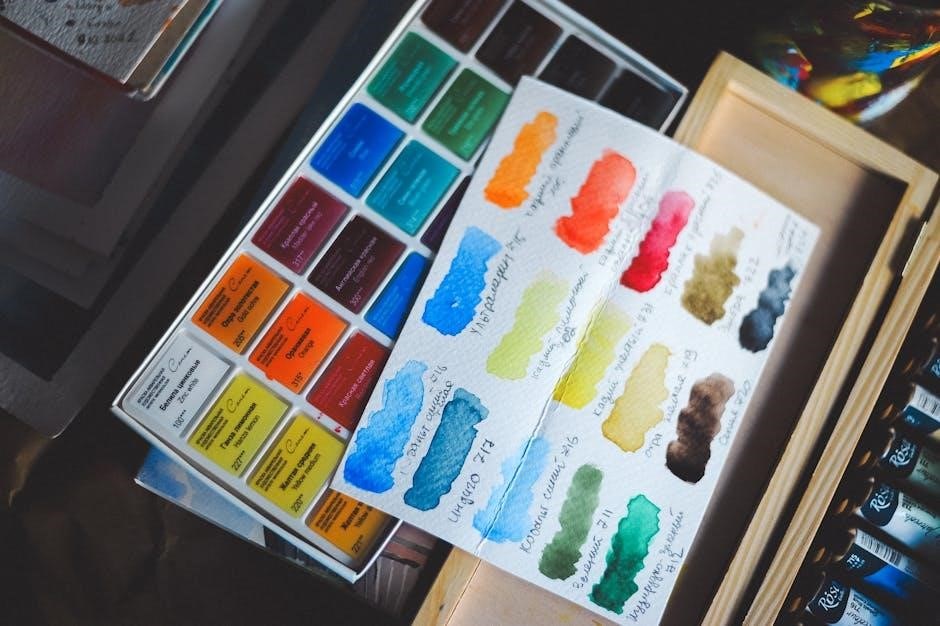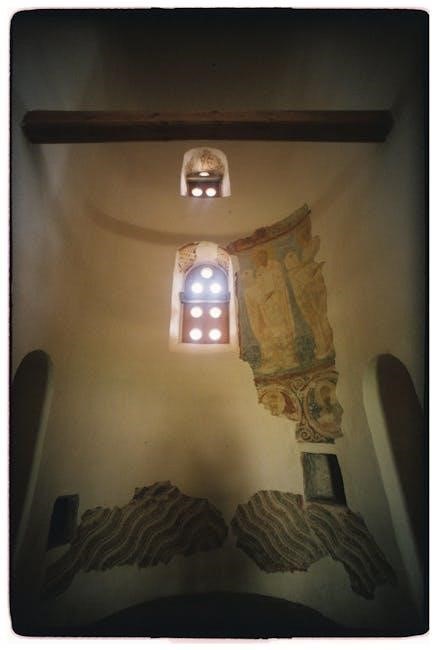A painting proposal is a detailed document outlining a contractor’s plan for painting a client’s space, ensuring clarity and professionalism in project execution and expectations.
1.1. What is a Painting Proposal?
A painting proposal is a detailed document outlining a contractor’s plan for painting a client’s property. It includes scope, materials, timeline, pricing, and terms, ensuring clarity and agreement. This document serves as a formal offer, providing a clear understanding of the project’s objectives, methods, and expectations. It helps clients make informed decisions and establishes a professional foundation for the work. A well-structured painting proposal ensures transparency, accountability, and mutual understanding between the contractor and the client.
1.2. Importance of a Painting Proposal
A painting proposal is essential for establishing clear expectations and ensuring a smooth project execution. It provides detailed plans, pricing, and timelines, helping clients understand the scope and costs involved. A well-crafted proposal demonstrates professionalism, builds trust, and showcases expertise. It also serves as a legal document, protecting both parties by outlining responsibilities and payment terms. A painting proposal is crucial for winning contracts, as it presents a clear, organized, and persuasive outline of the work to be performed, ensuring client confidence and project success.
1.3. Who Needs a Painting Proposal?
A painting proposal is essential for contractors, painters, and businesses offering painting services. It is also beneficial for homeowners, property managers, and commercial clients seeking to hire professionals for their painting needs. Additionally, artists and studios preparing projects for exhibitions or commissions may utilize proposals to outline their plans and costs. A painting proposal ensures clarity and agreement between service providers and clients, making it a vital tool for anyone involved in painting projects, regardless of scale or purpose.
Structure of a Painting Proposal
A painting proposal typically includes sections like header and contact info, client details, executive summary, scope of work, materials, timeline, pricing, and legal terms to ensure clarity and agreement.
2.1. Header and Contact Information
The header includes the contractor’s logo, company name, address, phone number, and email. This section ensures the client can easily contact the contractor for any inquiries or updates regarding the project. Including professional branding elements like logos enhances credibility and makes the proposal look polished. Additionally, providing clear contact information fosters trust and professionalism, making it easier for clients to reach out and discuss the proposal in detail. This section sets a positive first impression and establishes clear communication channels from the start.
2.2. Client Information and Project Details
This section includes the client’s name, address, and contact details, ensuring clear communication. It also outlines the project location, specific areas to be painted, and the desired outcomes. Including a detailed description of the work helps both parties understand the scope and expectations. This section ensures that all project specifics are documented, providing a clear reference point for the client and contractor. Accurate client information and project details are essential for a well-organized and professional proposal that meets the client’s needs effectively.
2.3. Executive Summary
The executive summary provides a concise overview of the painting proposal, highlighting the key objectives and deliverables. It summarizes the scope of work, timeline, and pricing to give the client a quick understanding of the project. This section is designed to be clear and to the point, ensuring the client can grasp the essential details without reviewing the entire document. A well-crafted executive summary enhances the professionalism of the proposal and helps build trust with the client by presenting the project’s value succinctly.
2.4. Scope of Work

The scope of work outlines the specific services and tasks included in the painting project. It details the areas to be painted, such as walls, ceilings, or trim, and specifies the number of coats. This section also covers surface preparation, like cleaning or repairing damages, and the materials to be used. The timeline for completion and any additional services, such as touch-ups, are included. The scope of work ensures clarity and prevents misunderstandings by clearly defining what is covered in the project. It is tailored to meet the client’s specific needs and expectations.
2.5. Materials and Methods
The materials and methods section details the products and techniques used for the painting project. It specifies the type and brand of paint, primers, and coatings, ensuring durability and quality. Surface preparation methods, such as sanding, cleaning, or repairing cracks, are outlined. Application techniques, like brushing, rolling, or spraying, are described. This section ensures transparency about the quality of materials and the professionalism of the workmanship, aligning with industry standards to achieve the desired finish and longevity of the paint job. Environmental considerations may also be included.
2.6. Timeline and Schedule
The timeline and schedule outline the project’s start and end dates, including key milestones. It details daily working hours and expected progress. Weather or unforeseen delays are addressed with contingency plans. This section ensures both parties are aligned on project pacing, helping clients understand when specific areas will be completed. A clear schedule fosters trust and organization, ensuring the project stays on track and meets deadlines effectively. Regular updates may be included to keep the client informed throughout the process.
2.7. Pricing and Payment Terms
This section outlines the total cost of the painting project, including materials, labor, and any additional expenses. It details payment schedules, such as deposits, installment payments, and final payment due dates. Payment methods and terms are clearly stated to avoid misunderstandings. The pricing structure may also include taxes or insurance costs. Transparency in pricing ensures both parties are aligned financially, building trust and ensuring smooth project execution. All terms are tailored to the client’s needs and industry standards.
2.8. Legal and Contractual Terms
This section outlines the legal obligations and rights of both parties. It includes terms for contract termination, liability clauses, and dispute resolution processes. Compliance with local laws and regulations is emphasized. Confidentiality agreements and intellectual property rights are also addressed. The language is clear and binding, ensuring both the contractor and client understand their responsibilities. These terms protect both parties and provide a framework for resolving any legal issues that may arise during the project. They are essential for maintaining professionalism and accountability.

Key Components of a Painting Proposal
A painting proposal must include detailed cost estimates, warranty information, and client testimonials to build trust and clarity. These elements ensure transparency and professionalism.
3.1. Detailed Cost Estimate
A detailed cost estimate in a painting proposal outlines all expenses, including materials, labor, and equipment. This transparency helps clients understand where their budget is allocated, ensuring no hidden fees and fostering trust. It typically breaks down costs per room or area, specifies paint types, and includes any additional services like surface preparation. Providing a clear, itemized breakdown ensures both parties are aligned on expectations and financial commitments. This section is crucial for project approval and client satisfaction.
3.2. Warranty and Guarantee Information
A painting proposal should include warranty and guarantee details to assure clients of the work’s quality and durability. This section typically outlines the duration of the warranty, what is covered (e.g., peeling, fading), and any conditions that may void the agreement. Including this information demonstrates professionalism and builds trust, as clients know they are protected against subpar workmanship or materials. Clear warranty terms also help prevent disputes and ensure long-term satisfaction with the painting project.
3.3. Insurance and Liability Coverage
Insurance and liability coverage are critical components of a painting proposal, ensuring protection for both the client and contractor. This section outlines the types of insurance held by the contractor, such as general liability and workers’ compensation, to cover accidental damage or injuries. It also specifies liability limits and any additional coverage for equipment or materials. Including this information reassures clients of the contractor’s professionalism and financial responsibility, minimizing risks and ensuring compliance with legal requirements. Transparency in insurance details fosters trust and safeguards all parties involved in the project.
3.4. Client Testimonials and References
Client testimonials and references are essential for establishing credibility in a painting proposal. They provide real-world feedback, showcasing a contractor’s reliability and quality of work. Including quotes or reviews from past clients highlights strengths and builds trust. References allow potential clients to verify satisfaction directly, reinforcing the contractor’s reputation. This section should be concise, featuring a few impactful testimonials that demonstrate expertise, professionalism, and customer satisfaction, helping to differentiate the contractor from competitors and increase the likelihood of securing the project.
3.5. Company Profile and Qualifications
A company profile and qualifications section highlights the contractor’s experience, certifications, and expertise in painting. It should include the company’s mission, years in business, and any relevant industry certifications. Mentioning specialized skills, such as working with specific materials or techniques, can set the contractor apart. This section builds credibility by showcasing the team’s qualifications and commitment to quality, ensuring clients feel confident in the contractor’s ability to deliver exceptional results tailored to their needs and expectations.

How to Create a Painting Proposal
Creating a painting proposal involves using templates for efficiency, customizing for each client, including visual elements, and thorough proofreading to ensure clarity and professionalism in the document.
4.1. Using Templates for Efficiency
Using templates for painting proposals streamlines the process, saving time and reducing manual effort. Templates provide a structured format, ensuring consistency and professionalism. They allow contractors to quickly customize details for each client, maintaining clarity and accuracy. Templates also help in organizing information, such as scope of work, pricing, and timelines, making it easier to present a polished document. By leveraging templates, contractors can focus on personalized touches rather than starting from scratch, enhancing efficiency and client satisfaction. This approach is particularly useful for recurring projects or similar client needs.
4.2. Customizing the Proposal for Each Client
Customizing a painting proposal ensures it aligns with the client’s specific needs and preferences. This involves tailoring project details, cost estimates, and timelines to reflect the unique requirements of each client. Personalized proposals demonstrate professionalism and attention to detail, enhancing client trust and satisfaction. By incorporating client-specific information, such as paint colors, surface types, and special requests, contractors can create a document that feels tailored to the client’s vision. This approach fosters a stronger client-contractor relationship and increases the likelihood of securing the project.
4.3. Including Visual Elements
Incorporating visual elements into a painting proposal enhances clarity and professionalism. High-quality images of previous work, color swatches, and before-and-after comparisons help clients visualize the final result. Diagrams or sketches of the project layout can also illustrate the scope of work. Additionally, including brand logos and professional graphics ensures a polished presentation. These visual aids make the proposal more engaging and easier to understand, fostering client confidence in the contractor’s ability to deliver exceptional results.

4.4. Proofreading and Editing
Proofreading and editing are crucial steps in creating a professional painting proposal. Ensuring the document is free from grammatical errors, typos, and formatting issues enhances credibility. Reviewing the content for clarity and coherence guarantees that the client understands the scope and terms. Edits should also verify that all client-specific details are accurate, reflecting the tailored approach to their project. A polished proposal not only demonstrates attention to detail but also strengthens the client’s trust in the contractor’s expertise and reliability.
Types of Painting Proposals
Painting proposals vary by project type, including residential, commercial, exterior, and interior painting. Each category requires tailored details to meet specific client needs and expectations effectively.
5.1. Residential Painting Proposals
Residential painting proposals are tailored for homeowners, detailing plans for interior or exterior painting. They include specific details like rooms, surfaces, paint types, and timelines. The document ensures clarity on scope, materials, and costs, helping homeowners visualize the transformation. A well-structured residential proposal builds trust and sets clear expectations, making it easier for clients to approve the project. Contractors often use templates to streamline this process, ensuring professionalism and efficiency.

5.2. Commercial Painting Proposals
Commercial painting proposals are designed for businesses, outlining plans for large-scale projects like office buildings, retail spaces, or industrial facilities. These documents detail materials, timelines, and costs, ensuring minimal disruption to operations. They often include specific paint types for durability and aesthetics, tailored to the business environment. Commercial proposals may also emphasize safety protocols and adherence to regulations. Using templates, contractors can efficiently create customized proposals, fostering professional relationships and securing long-term clients in the commercial sector.
5.3. Exterior Painting Proposals
Exterior painting proposals are tailored for outdoor projects, addressing unique challenges like weather conditions and surface preparation. They outline materials suitable for outdoor use, ensuring durability and resistance to environmental factors. These proposals often include detailed plans for trimming, siding, and other exterior elements. Contractors emphasize the importance of weather-resistant paints and proper application techniques to maintain the structure’s appearance and integrity. Exterior painting proposals also provide timelines and cost estimates, helping clients visualize the transformation of their property’s exterior.
5.4. Interior Painting Proposals
Interior painting proposals focus on enhancing the aesthetic appeal of indoor spaces. They detail specific areas to be painted, such as walls, ceilings, and trim, and outline the types of paint suitable for different rooms. These proposals often include color consultations and finish options, ensuring the final result matches the client’s desired style. Contractors also specify preparation steps, like furniture removal and surface repair, to guarantee a smooth and professional outcome. The proposal may additionally highlight eco-friendly paint options for health-conscious clients, making it a comprehensive guide for interior transformations.
Digital Painting Proposals
Digital painting proposals streamline the process by utilizing templates and tools, allowing contractors to create and share detailed, professional plans efficiently while facilitating real-time collaboration with clients.
6.1. Benefits of Digital Proposals
Digital painting proposals offer enhanced efficiency, allowing contractors to create and share detailed plans quickly. They provide professional presentation, easy customization, and real-time collaboration, improving client communication. Digital formats reduce paper waste and storage needs, making them environmentally friendly. Contractors can easily track changes and updates, ensuring transparency. Digital proposals also enable quick access to templates, reducing preparation time. They facilitate faster approvals and reduce delays, streamlining the project workflow. Overall, digital proposals modernize the bidding process, making it more convenient and effective for both contractors and clients.
6.2. Tools for Creating Digital Painting Proposals
Various tools simplify the creation of digital painting proposals, such as Adobe InDesign and Canva for design, and ProposalKit or JobNimbus for streamlined templates. Procore and CoConstruct offer project management features, while PDFescape and DocHub enable easy editing of PDF files. These tools help contractors create professional, customizable proposals quickly, ensuring consistency and accuracy. They also support integration with other software, making it easier to manage client interactions and project details efficiently.
6.3. Best Practices for Digital Submissions
When submitting digital painting proposals, ensure clarity and professionalism by using clear fonts and proper formatting. Include high-quality images to showcase previous work and enhance credibility. Proofread thoroughly to avoid errors. Utilize interactive elements like hyperlinks to portfolios or testimonials for added convenience. Ensure compatibility across devices by saving files in widely accepted formats like PDF. Secure your document with passwords if necessary. Regularly update templates to reflect current projects and client feedback, maintaining a polished and trustworthy appearance.

Legal Considerations in Painting Proposals

Legal considerations ensure contracts are binding, outlining liability, payment terms, and cancellation policies. Clear terms protect both parties, avoiding disputes and ensuring compliance with local regulations.
7.1. Contractual Obligations
Contractual obligations in painting proposals define the responsibilities of both the contractor and the client. These legally binding agreements outline the scope, timelines, and deliverables, ensuring both parties are committed to the terms. They also specify the consequences of breaching the contract, such as penalties or termination. Clear contractual obligations protect the interests of all involved, fostering trust and accountability. Properly drafted contracts prevent misunderstandings and ensure smooth project execution.
7.2. Liability Clauses
Liability clauses in painting proposals protect both the contractor and the client from potential risks. These clauses specify who is responsible for damages or injuries during the project. They often include provisions for accidental damage to property or injury to workers. Liability clauses ensure that both parties understand their responsibilities and limitations. Clear wording helps prevent disputes and ensures that all risks are accounted for. Properly drafted liability clauses provide a safeguard for both the contractor and the client, ensuring a fair and protected agreement. They are essential for maintaining trust and accountability throughout the project.
7.3. Payment Terms and Conditions
Payment terms and conditions in a painting proposal outline the agreed-upon financial arrangements. They specify payment methods, due dates, and late fees. Common terms include deposit requirements, progress payments, and final payment upon completion. These terms should be clear to avoid disputes. Conditions may also cover refunds, cancellations, or penalties for delayed payments. Ensuring transparency in payment terms builds trust and ensures smooth project execution. Properly structured terms protect both the contractor and client, fostering a mutually beneficial agreement. Clarity is key to maintaining a positive working relationship throughout the project.
7.4. Cancellation Policies
Cancellation policies in a painting proposal outline the conditions under which either party can terminate the agreement. These policies must be clearly stated to protect both the client and contractor. Typically, cancellations must be made in writing and signed by both parties. The policy may include notice periods, penalties for early termination, or refunds if work has not commenced. It’s essential to ensure terms are fair and transparent, avoiding disputes. Cancellation policies should also specify how deposits or progress payments will be handled if the project is terminated prematurely. Clarity in these terms fosters trust and mutual understanding.

Financial Aspects of Painting Proposals
Financial aspects of painting proposals include cost estimation, budget breakdown, payment schedules, and tax considerations, ensuring transparency and fairness for both clients and contractors.
8.1. Cost Estimation Techniques
Cost estimation techniques in painting proposals involve detailed breakdowns of materials, labor, and equipment costs. Surface preparation, protection of surroundings, and application methods are considered; Pricing structures may include fixed rates or per-square-foot charges. Profit margins and overheads are calculated to ensure profitability. Variables like location, project size, and complexity are factored in. Transparent and accurate cost estimates build trust with clients and ensure smooth project execution. Proper estimation techniques prevent cost overruns and align expectations for both parties.
8.2. Budget Breakdown
A budget breakdown in a painting proposal outlines the allocation of funds across project components. It typically includes costs for paints, primers, tools, and labor. Additional expenses like surface preparation, protective coverings, and equipment rentals are itemized. The breakdown may also detail fixed costs versus variable costs, ensuring transparency for the client. This structured approach helps in tracking expenses and managing financial resources effectively, ensuring the project stays within budget. A clear breakdown fosters trust and provides a financial roadmap for both parties.
8.3. Payment Schedules
A payment schedule in a painting proposal outlines the timing and amounts of payments due throughout the project. It typically includes an initial deposit, midpoint payments, and a final payment upon completion. The schedule ensures cash flow for the contractor and provides clarity for the client. Terms may include payment methods, late fees, and conditions for adjustments. A clear payment schedule helps maintain trust and ensures both parties meet their financial obligations, aligning with the project’s progress and deliverables.
8.4. Tax and Insurance Considerations
Tax and insurance considerations are crucial in a painting proposal to ensure compliance and financial protection. Contractors must account for sales tax on materials and services, depending on local regulations. Liability insurance coverage is essential to protect against accidents or property damage. Workers’ compensation insurance may also be required, depending on the project’s scope and location. These elements ensure transparency and safeguard both parties, preventing unforeseen financial burdens and ensuring a smooth project execution.
A well-crafted painting proposal ensures clarity, professionalism, and mutual understanding, facilitating smooth project execution and fostering trust between contractors and clients.

9.1. Summary of Key Points
A painting proposal is a comprehensive document detailing plans, costs, and timelines for painting projects. It ensures clarity and professionalism, outlining materials, methods, and legal terms. Using templates streamlines creation, while customization tailors proposals to client needs. Including visual elements enhances understanding, and thorough proofreading ensures accuracy. Digital tools facilitate efficient submissions, and adherence to best practices maintains professionalism. A well-structured proposal fosters trust, ensuring smooth project execution and client satisfaction. It serves as a foundational agreement, guiding both parties through the painting process effectively. Professionalism and attention to detail are paramount in crafting successful proposals.
9.2. Final Tips for Creating Effective Painting Proposals
Ensure clarity and professionalism in your proposal by including detailed breakdowns of costs, timelines, and materials. Tailor each proposal to the client’s specific needs, emphasizing how your services will meet their expectations. Use visual elements like before-and-after images to enhance understanding. Proofread thoroughly to avoid errors, and leverage digital tools for streamlined creation. Highlight your qualifications and past successes to build trust. Always maintain a professional tone and be responsive to client inquiries. These steps will help you create compelling, effective painting proposals that win projects and foster long-term client relationships.
9.3. Importance of Professionalism in Proposals
Professionalism in painting proposals is crucial for building trust and credibility with clients. A well-structured, error-free document reflects your expertise and reliability. Ensure clear communication of project details, timelines, and costs. Proper formatting and a polished presentation convey professionalism, setting you apart from competitors. Attention to detail and a thorough approach demonstrate your commitment to quality. By maintaining a professional tone and appearance, you establish a strong foundation for client relationships and increase the likelihood of securing projects. Professionalism is key to fostering confidence and long-term partnerships with clients.
